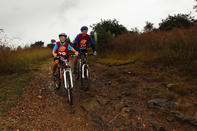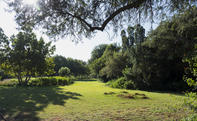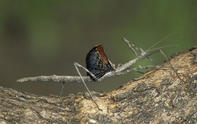Nature Trails
Nature lovers can enjoy the many bird sanctuaries dotted around Tshwane, like the Chamberlain Bird Sanctuary, which is a bird hide in a city reserve.

There are the National Botanical and National Zoological Gardens, Wonderboom, with its magnificent wild figs, and Groenkloof Nature Reserve, with its hiking trails, horse trails and mountain bike trails. There is also a 4x4 route to test your off-road skills.
Rietvlei Nature Reserve, just 18 km outside of the city centre, has some 1600 head of game including springbok, black wildebeest, eland, Burchell's zebra and more.
Guided night drives can also be taken to view the nocturnal species such as brown hyena, black-backed jackal and aardwolf. White rhino and eland spotting can be done at the nearby Dinokeng Game Reserve, north-east of Pretoria, the only Big 5 game reserve in Gauteng.
Jacaranda City
Tshwane is an absolute sight in October and November when the city's Jacaranda trees erupt into a dazzle of purple flowers. When the flowers drop from the trees, they create gorgeous mauve carpets at their trunks.
Pretoria National Botanical Garden

Nearly half of South Africa's indigenous tree species grow in the Pretoria National Botanical Garden, which also has some fine examples of the fauna of Southern Africa and more than 600 species of flowering plants. A paved nature trail through a rocky ridge shows Pretoria's natural vegetation state before all the building happened. Some 20 ha are natural flora Oasis.
The Pretoria garden spans 76 hectares, divided by a quartzite ridge. It is a microcosm of the Magaliesberg, and what makes the Magaliesberg special, botanically speaking, is that it is the ecotone between Highveld grassland and bushveld savanna, with some Afro-montane survivors.
Stick Insects

The Wonderboom
This is the curious case of a single tree in Tshwane that made its own forest, which explains the name. This species of ficus sends out long, drooping branches that set roots and grow trunks wherever they touch the ground. But even within its impressive species, this specimen is little short of miraculous.
was once many times bigger than its current extent of a whopping 50 m in diameter, with 15 distinct trunks. Legend has it that an important chief of a long-gone tribe was aril.
That is why the tree grew so big (it would have to have been more than 1000 years ago). It was named Wonderboom (‘miracle tree') by Andries Hendrik Potgieter’s Voortrekker column, who used it as an outspan. The story goes that it could Shade 22 wagons with full ox teams. or some 1000 people. Sadly, fires and parasitic infestation have greatly reduced its size.
By David Bristow